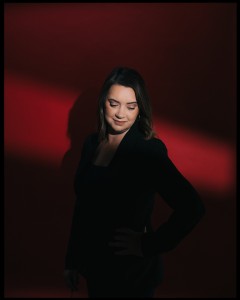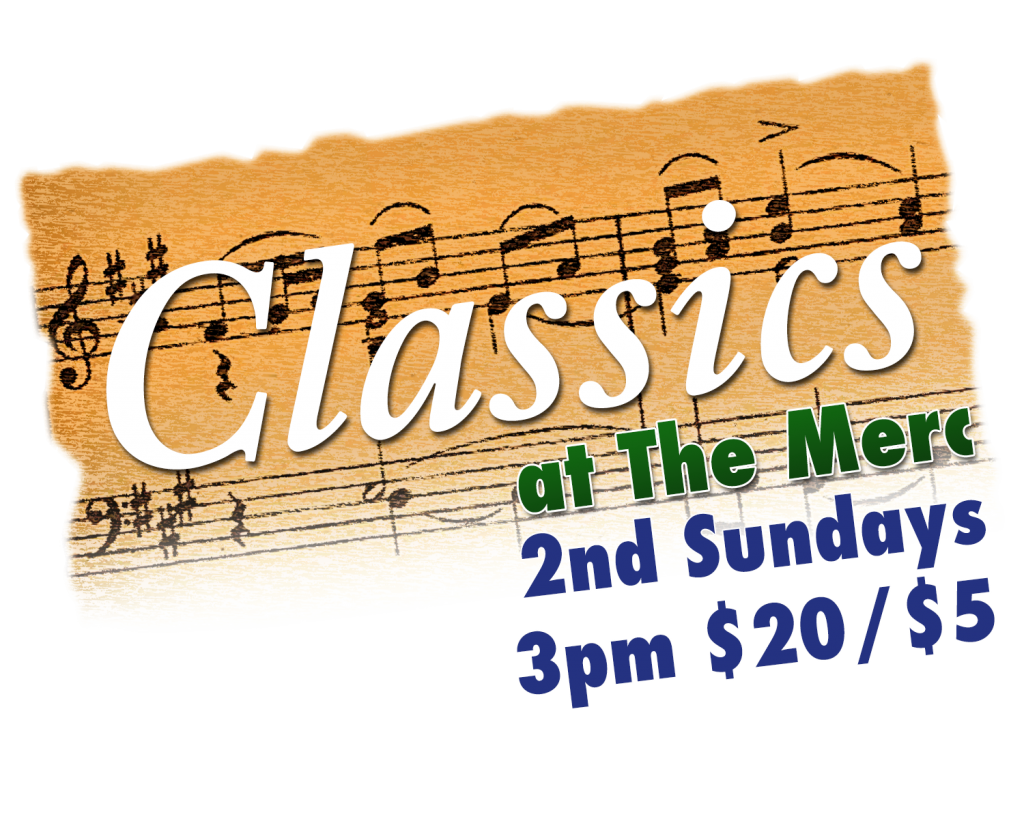Rebecca Schlappich Charles & Eliza James, violins
Jennifer Wu, viola; Danica Pinner, cello
Archangelo Corelli
Christmas Concerto (excerpts)
Traditional/Tchaikovsky
Joy to the World/Trepak
Traditional
Wexford Carol/Go Tell It on the Mountain
Irving Berlin
White Christmas
Additional selection to be announced
INTERMISSION
Please join us in the Gallery for a glass of bubbly and a treat!
Walter Kent
I’ll Be Home for Christmas
Frank Loesser
What Are You Doing New Year’s Eve
Traditional
Auld Lang Syne
We Wish You a Merry Christmas
Additional selection to be announced
Ankur Mukhopadhyay, piano
Ludwig Van Beethoven (1770-1827)
Sonata Op. 81a 1st movement
Claude Debussy (1862-1918)
The Gate of Wine Prelude
Intermission
Frederic Chopin (1810-1849)
Nocturne Op. 48 No. 1
Sergei Rachmaninoff (1873-1943)
Sonata No. 2 2nd and 3rd movement
Tango Obsession
Beth Ross Buckley, flute; David Buckley, violin
Andrés Martin, double bass; Dana Burnett, piano
A powerful program of tango through time – a curated time-travel experience highlighting several famous traditional tango composers.
El Marne Eduardo Arolas (1892-1924)
Tanguera Mariano Mores (1918-2016)
Adiós Nonino Astor Piazzolla (1921-1992)
Recuerdo Osvaldo Pugliese (1905-1995)
Brutal Andrés Martín (b.1981)
INTERMISSION
Inspiración Enrique Mario Francini (1916-1978), Armando Pontier (1917-1983)
A don Agustin Bardi Horacio Salgán (1916-2016)
Lifemakers Andrés Martín (b.1981)
- A Don Humberto Gaspar
- Like Water
- Ding Dong Danger
Christa Marie Stevens, soprano
Marco Antonio Lozano, tenor
Robert Sage, Piano
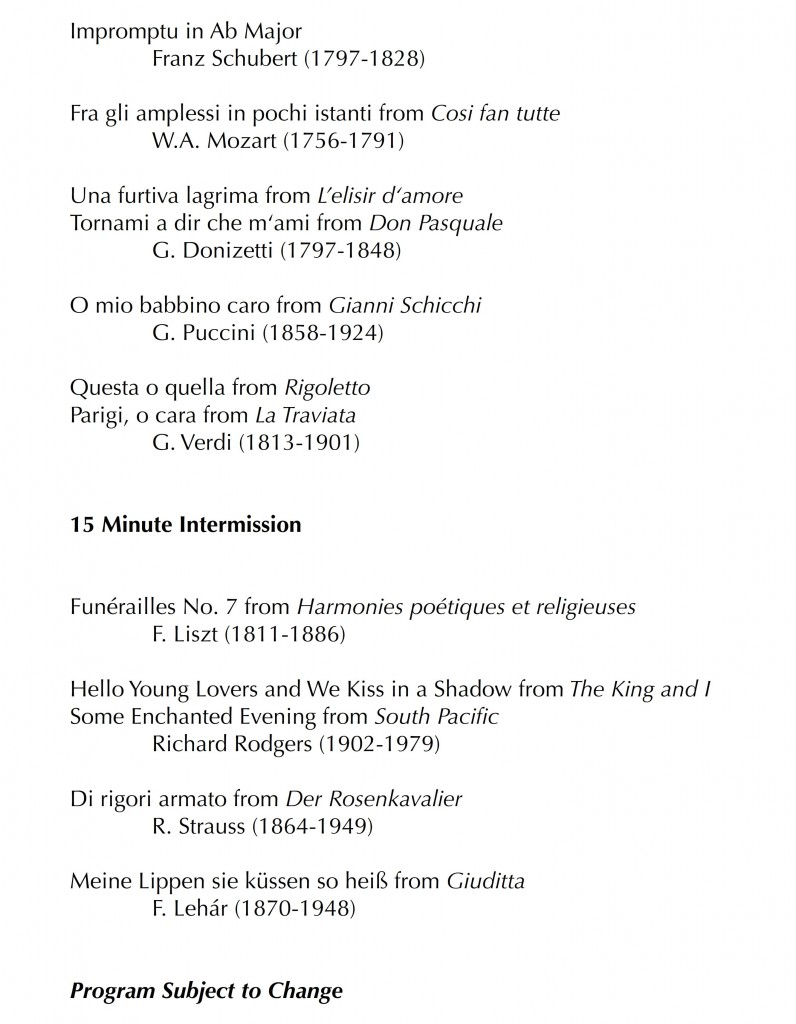
Steve Huber & Andrew Kwon, violins;
Linda Piatt, viola; Ruslan Biryukov, cello
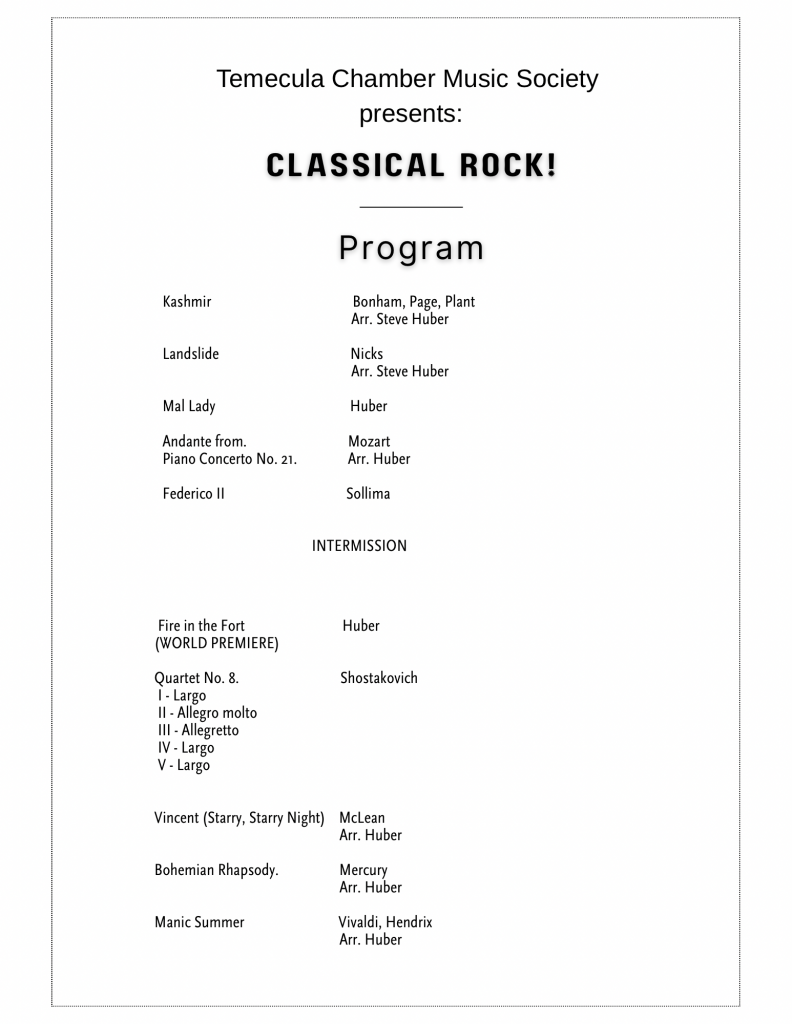
Alan Roberto Lopez, harmonica
Tatiana Senderowicz, guitar
Astor Piazzolla (1921-1992)
Yo Soy Maria
Alan Roberto Lopez (1991- )
Desvelada
Lengua Al Viento
Ariel Ramirez (1921-2010) Arr. by Tatiana Senderowicz and A.R. Lopez
Alfonsina y el Mar
A. R. Lopez
Preludio
Decadencia
Intermission
Piazzolla Arr. by Tatiana Senderowicz and A.R. Lopez
Chiquilin de Bachin
Fracanapa
Sergio Assad (1952- )
Midnight Tango Pursuit
Piazzolla
Arr. by Tatiana Senderowicz and A.R. Lopez
Soledad
Zita
Libertango
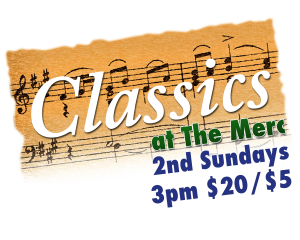
Batya MacAdam-Somer & Missy Lukin, violins
Annabelle Terbetski, viola
Elizabeth Brown, cello
Franz Joseph Haydn (1732 – 1809)
String Quartet Op. 33, No. 3 “The Bird”
Allegro moderato
Scherzo, Allegretto
Adagio ma non troppo
Finale, Presto
Jessie Montgomery (b. 1981)
Strum
INTERMISSION
Danish String Quartet
Last Leaf, The complete Collection
Shore
Polska from Dorotea
Tjønneblomen
Menuet No. 60
Æ Rømeser
Intermezzo
Shine You No More
Drømte Mig En Drøm
Stӕdelil
Naja’s Waltz
Unst Boat Song
Hur Var Du I Aftes Så Sildig
The Dromer
Program Notes
Strum is the culminating result of several versions of a string quintet that I wrote in 2006. It was originally written for the Providence String Quartet and guests of Community MusicWorks Players, then arranged for string quartet in 2008 with several small revisions. In 2012 the piece underwent its final revisions with a rewrite of both the introduction and the ending for the Catalyst Quartet in a performance celebrating the 15th annual Sphinx Competition.
Originally conceived for the formation of a cello quintet, the voicing is often spread wide over the ensemble, giving the music an expansive quality of sound. Within Strum I utilized texture motives, layers of rhythmic or harmonic ostinato that string together to form a bed of sound for melodies to weave in and out. The strumming pizzicato serves as a texture motive and the primary driving rhythmic underpinning of the piece. Drawing on American folk idioms and the spirit of dance and movement, the piece has a kind of narrative that begins with fleeting nostalgia and transforms into ecstatic celebration.
-Jessie Montgomery
Haydn’s 83 string quartets span nearly his entire career, but rather than being written continuously, they appeared in bunches. When the six quartets of his Opus 33 were completed in 1781, they were his first quartets in nine years. Haydn offered handwritten copies of the manuscripts to wealthy patrons, advertising them as having been written “in a quite new, special manner.” Exactly what he meant by this has been the source of some debate, and cynical commentators have felt that Haydn’s enthusiasm for the novelty of these quartets was merely a sales pitch. String Quartet Op. 33 No. 3 “The Bird” takes its nickname from the chirping grace notes that decorate many of its themes. Over steady accompaniment from the middle voices, the first violin announces the main theme of the Allegro moderato. Next, the second movement he marks Scherzando which is different than the sort of scherzo that Beethoven would write a generation later. It is faster than minuet tempo, and surprising accents give the melodic lines unusual weight. The outer sections remain in the lowest registers of all four instruments (it is said of this movement that C major has never sounded so dark as it does here), and the trio section offers several surprises: including a duo for the two violins only, and bringing back some of the “bird music” of the opening movement. The Adagio belongs almost entirely to the first violin its simple opening melody grows florid and complex as the movement unfolds. The finale is a rondo reportedly based on a Slavonic folk tune. This movement, aptly marked Presto, zips along with unflagging energy. Seldom has there been more gloriously apt writing for string quartet, and seldom has there been more cheerful music than this graceful romp, which rushes right to its close and, like smoke, disappears silently and effortlessly.
-Eric Bromberger
Last Leaf, the complete collection is a mix of traditional folk music that has been passed down through an oral tradition and a few newly composed tunes by members of the Danish String Quartet.
Shore is a little folk-fantasy simply inspired by the vast coastline and the many hundreds of islands that form Denmark.
Polska from Dorotea, this tune has a natural sense of gravity and swing, and in almost la follia-like progression. Although the polska dance tends to be a tad slower, we like it when played with “strum und drang”!
Tjønneblomen at first listen may seem very traditional, but it has an unusual five-part structure, revealing that it is a contribution to the modern concert stage, rather than just a traditional dance tune. People still discuss whether the composer wrote it as a tribute to his homestead, or to the girl that he loved but never got…
Menuet no. 60 was part of a collection written down in the 1760’s by Rasmus Storm, one of the earliest collections of Danish folk melodies. Almost half of his melodies were minuets, a sign of how popular this dance was in the latter part of the 18th century.
Æ Rømeser is one of the traditional sonderhonings from the 18th century, the title simply means The one from Rømø (the first island south of Fanø, perhaps the origin of this particular dance).
Intermezzo, just as it sounds, is a little musical break that comes and goes faster than a daydream.
Shine You No More was inspired by a tune by renaissance composer John Dowland called Flow My Tears from 1596.
Drømte Mig En Drøm is notated on the last leaf of parchment in the Codex Runicus, a codex from the beginning of the 13th century, written in runes. It includes the Scanian Law – the oldest know provincial text in Scandinavia – and it chronicles the early Danish monarchs. Most scholars agree that this is a song about justice and fairplay.
Stӕdelil is a traditional Danish ballad telling a story of magic and love. This tune was also arranged for soprano, four-part chorus and piano by Beethoven in the 1810’s.
Naja’s Waltz is an asymmetrical waltz with a little Norwegian touch.
Unst Boat Song is a simple and rather captivating melody. Real Viking music, with the three surviving verses partly in Norse and partly extinguished dialect, suggests that it is very old. It is a song about the strong winds at sea, the difficulties of handling the boat and the prayer for coming home safely.
Hur Var Du I Aftes Så Sildig is a mysterious tune from Storm’s collection with an unusual bar structure of 3+5 making it unsuitable for all known Danish dances in the 18th century.
The Dromer is technically an English dance. In the final decades of the 18th century, dances from the British Isles were very much in fashion in Denmark. This tune later morphed into a Scottish tune which was used to stir up the chiefs and their clans.
About Quartet Nouveau
Quartet Nouveau & Chamber Music Institute formed as a 501 © 3 nonprofit organization in January 2013 with the mission of for making chamber music available to the entire San Diego community. Quartet Nouveau is a string quartet based in San Diego where all four musicians freelance and teach within the community. Known for their fresh approach to classical music, they hope to inspire students to play this very same music one day. The members of Quartet Nouveau all graduated from the nation’s top universities with Masters and Doctoral degrees. These musicians also perform with the San Diego Symphony, The California Chamber Orchestra, Classics 4 Kids Philharmonic, La Jolla Playhouse, and the Old Globe. Quartet Nouveau has performed in school educational outreach concerts students from kindergarten to high school throughout southern California. For more information visit quartetnouveau.org

Sunday, April 27, 2025, 3:00 p.m.
Gershwin Performing Arts Center | Murrieta Mesa High School
Today’s Program
Aaron Copland (1900 – 1990)
Hoe-Down from Rodeo
Florence Price (1887 – 1953)
Andante Cantabile from String Quartet No. 2
George Antheil (1900 – 1959)
Serenade for String Orchestra
1. Allegro
2. Andante Molto
3. Vivo
INTERMISSION
Aaron Copland
Appalachian Spring Suite (Ballet for Martha)
Thanks to the Murrieta Valley Unified School District for their support of this concert.
Concession proceeds from today’s program benefit the Murrieta Educational Foundation for the Arts.
About Our Artistic Director and Conductor
Dana Zimbric is marking her 14th season as Artistic Director and Conductor of the California Chamber Orchestra.
In addition to her work with us, she is Music Director of the Classics Philharmonic Orchestra, which performs educational programs for San Diego area students, and recently made her conducting debut with the San Diego Symphony.
Dana’s past conducting experience includes positions with the San Diego Youth Symphony, Avante Chamber Orchestra, Orchestra Nova San Diego, and the University of Wisconsin Chamber and Symphony Orchestras.
An accomplished clarinetist, Dana holds a Bachelor of Music in Clarinet Performance and a Master of Music in Orchestral Conducting from the University of Wisconsin. She lives in San Diego with her husband and two young daughters.
Members of the California Chamber Orchestra
Violin I
Missy Lukin (Concertmaster)
Evan Pasternak
Violin II
Margeaux Maloney (Principal)
Victoria Bietz
Viola
Linda Piatt (Principal)
Annabelle Terbetski
Cello
Andrew Hayhurst (Principal)
Margaret Tait
Bass
PJ Cinque (Principal)
Flute
Pam Martchev (Principal)
Clarinet
Sheryl Renk (Principal)
Bassoon
Valentin Martchev (Principal)
Piano
Karen Follingstad (Principal)
Orchestra Personnel Manager and Music Librarian
Michael Molnau
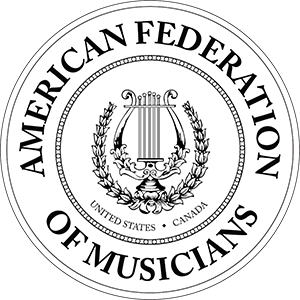
California Chamber Orchestra musicians in this concert are members of The American Federation of Musicians, Local 325
Program Notes
This afternoon’s concert celebrates American composers who wove elements of American folk music into the fabric of their classical works.
We open with Hoe-Down from Rodeo by Aaron Copland (1900–1990). Written in 1942, Rodeo is a ballet that pays homage to the American West. The energetic and familiar tune in Hoe-Down was transcribed almost note for note from a 1937 field recording of Kentucky fiddler William Stepp performing “Bonaparte’s Retreat.” That recording, captured by Alan and Elizabeth Lomax for the Library of Congress, preserved a traditional Irish American fiddle tune that Copland later adapted into a now-iconic orchestral piece. Many will recognize Hoe-Down from its use in commercials—most famously the “Beef. It’s What’s for Dinner” campaign—and in numerous film scores.
Florence Price (1887–1953), born in Little Rock, Arkansas, demonstrated remarkable musical talent from an early age. With a music teacher for a mother and a dentist for a father, she gave her first piano performance at age 4, published her first composition at 11, and graduated as valedictorian of her high school class at 14. Price excelled at the New England Conservatory, where she studied piano and organ, graduating with honors in 1906. In 1933, after years of teaching, raising a family, and striving for recognition in a segregated classical music world, Price made history when her Symphony in E minor was performed by the Chicago Symphony Orchestra—making her the first Black American woman to have her work performed by a major U.S. orchestra.
Today, the California Chamber Orchestra performs Price’s Andante Cantabile from her String Quartet No. 2. Contemplative and serene, the movement draws upon the spirit of the African American spiritual, evoking a soulful, blues-infused atmosphere.
Next, we turn to American composer George Antheil (1900–1959), a bold and eccentric figure who proudly called himself the “Bad Boy of Music.” Born in Trenton, New Jersey, to German immigrant parents, Antheil was an avant-garde composer, pianist, inventor, and writer. In the 1920s, he lived in Europe, mingling with cutting-edge artists who sought to break away from traditional forms. But by the late 1940s, Antheil had grown disillusioned with experimental, atonal modernism. He wrote that he wanted “to disassociate myself from the passé modern schools of the last half century, and to create a music for myself and those around me which has no fear of developed melody, real development itself, tonality, or other understandable forms.”
With that philosophy in mind, he composed his String Serenade, a three-movement work that includes quotations from the Civil War tune “Battle Cry of Freedom.” The result is a piece that blends craftsmanship, clarity, and Americana.
We close this celebratory concert with selections from Appalachian Spring, another ballet score by Aaron Copland, composed in 1944. Commissioned by Elizabeth Sprague Coolidge and choreographed by the legendary Martha Graham, the ballet is set in a rural Pennsylvania community in the 19th century. It tells the story of a young bride and her husband, alongside archetypal figures such as the Pioneer Woman and the Revivalist. Copland’s score is sparse, open, and hymn-like at times, and it beautifully incorporates the Shaker tune “Simple Gifts.” We are pleased to present this work in its original chamber instrumentation for strings, flute, clarinet, bassoon, and piano.
— Dana Zimbric
Thank You to Our Sponsors and Donors
Society Sponsors
Judy Call
Prudhomme Associates, CPAs
City of Temecula
Leslie and Joseph Waters
Season Sponsors
Mark Margolin
Nicola Helm & Stephen Ryder
Education Sponsors
Craig Carper, LaPointe Wealth Management
Murrieta Rotary
Concert Sponsors
Susan & Ken Dickson
Walt Fidler
Soloist’s Circle
Kiyoe MacDonald
Concertmaster’s Circle
Terry Kvitky
Kathryn McCarty
Barry Weiss
Rudy Wokoek
Principal’s Circle
John Welniak
Musician’s Circle
Candace Flint
Karen Hartnett
Susan Humphrey
Sarah Ivar
Martha Minkler
Sana Quijada
Join us at The Merc on the 2nd Sunday of each month for recitals by some of the region’s best musicians. These intimate performances include opportunities to hear from the musicians about their art, their careers, and the music being performed.

Marco Antonio Lozano, tenor
Christa Stevens, soprano
Miloš Veljković, piano
Etude and Elegiaco from Op.76 J. Sibelius (1865-1957)
In The Mandarin‘s Orchid Garden G. Gershwin (1898-1937)
My Ship K. Weill (1900-1950)
Lady in the Dark
Speak Low
One Touch of Venus
Lonely House
What Good Would The Moon Be?
We’ll Go Away Together
Street Scene
Magische Töne K. Goldmark (1830-1915)
Die Königin von Saba
Wien, du Stadt meiner Träume R. Sieczyński (1879-1952)
INTERMISSION
Nocturne in E flat Major, Op. 9 F. Chopin (1810-1849)
Cäcilie R. Strauss (1864-1949)
Morgen
Kein Andres, das mir so im Herzen loht
Capriccio
Oh, Happy We L. Bernstein (1918-1990)
Candide
Vilja Lied F. Lehár (1870-1948)
Die lustige Witwe
Meine Lippen, sie küssen so heiß
Giuditta
O soave fanciulla G. Puccini (1858-1924)
La bohème

Kate Prestia-Schaub, flute
Cat Cantrell, oboe
Margaret Worsley, clarinet
Annie Ranzani Makarchuk, bassoon
Kristin Morrison, horn
Classics for Classics at The Merc
Gustav Holst (1874 – 1934)
Jupiter
Claude Debussy (1862 – 1918)
La Fille aux cheveux de lin
Nikolai Rimsky-Korsakov (1844 – 1908)
Scheherazade
INTERMISSION
Wolfgang Amadeus Mozart (1756 – 1791)
Eine Kleine Nachtmusik
Sergei Prokofiev (1891 – 1953)
Peter and the Wolf
Camille Saint-Saens (1835 – 1921)
Samson and Delilah
Page 1 of 9 1 2 3 4 5 » ... Last »





